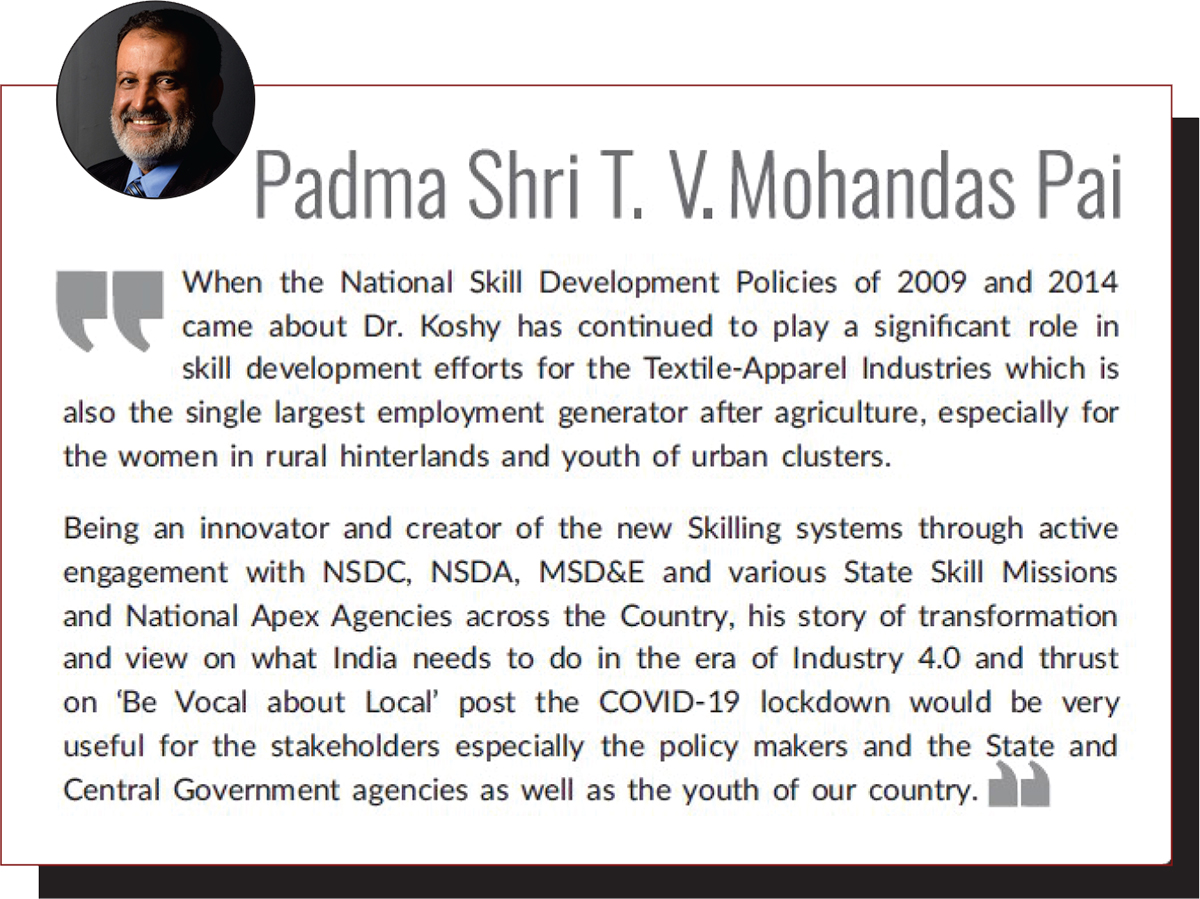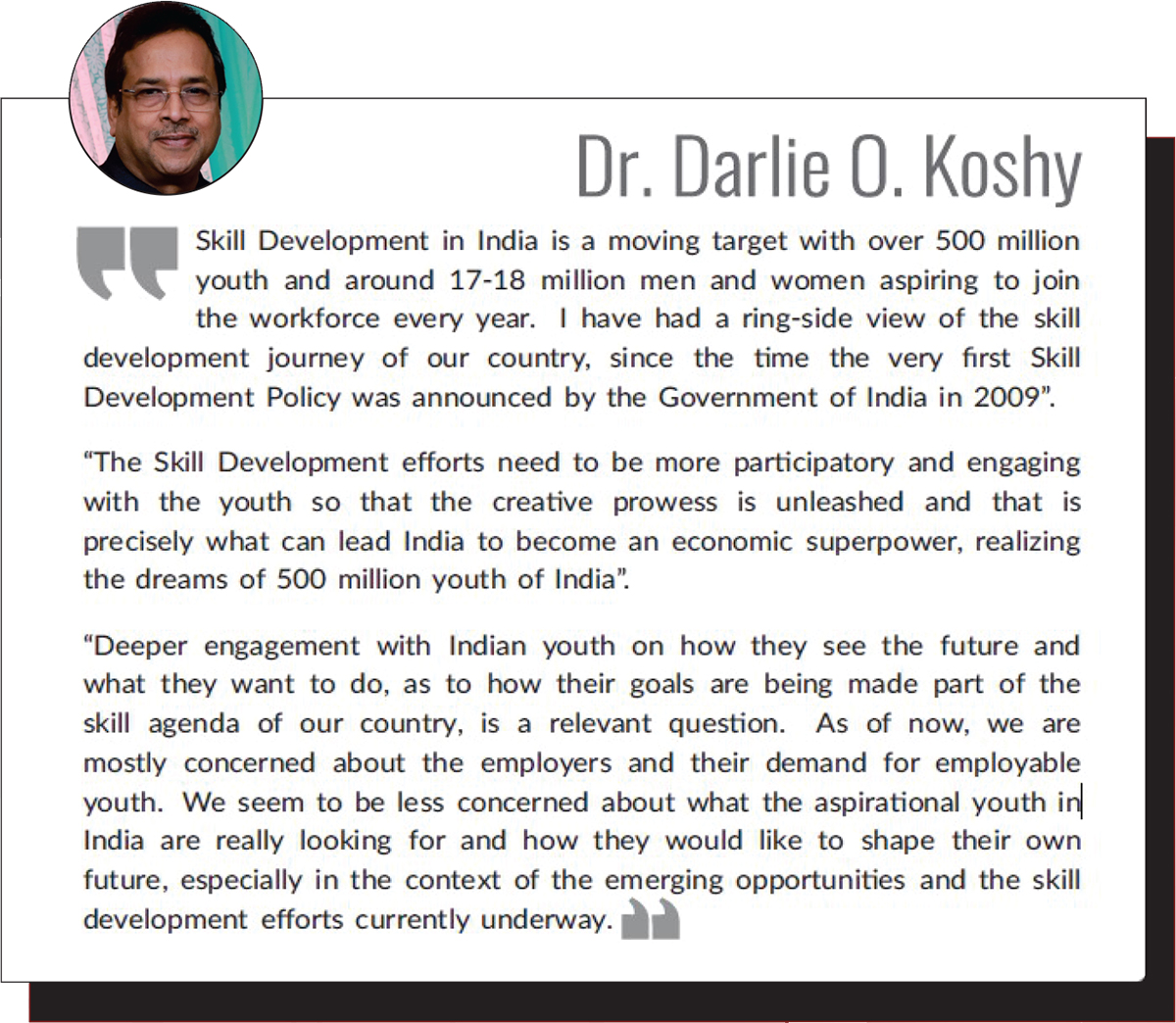
Executive Summary
Based on vast experience and expertise, the book delves deeper into how demand-driven skilling could take Indian industry to newer heights, enhance employability of women and youth, and accelerate economic growth by focusing on the local and rural economy. At the same time, there is sustained focus on the use of digital technologies to meet the challenges of skill development in the post-COVID-19 scenario.
The book starts by discussing the need for a skilling revolution in India and the ways in which this dream can turn into a reality. With a firm belief that India’s demographic dividend is yet to be utilised, a significant part of the book discusses how we bring in requisite changes from policy to practice by involving various stakeholders.
The emphasis on revisiting how training programs are designed and delivered in the context of ‘going local and digital’ clearly indicates India’s future lies in reviving local crafts and create an ecosystem that supports self-employment and entrepreneurship.
One cannot evaluate the quality of skills without presenting at a global stage and without meeting the global standards. Here lies the importance of the WorldSkills competitions. The industries must aspire to manufacture products that meet global standards and increase exports from the country. Skilling in India cannot just be about training and upgrading of the youth, it must ensure sustainable and equitable development of societies and communities. The local art and crafts of India provide the country with a range of niche skills that could be utilised for sustainable livelihoods. This opens up a space for having a Crafts University that recognises and skills youth in the regional crafts and arts of India. E-commerce is one of the ways in which local skills of India can be marketed to consumers worldwide.
This books stresses on the importance of Reskilling, Upskilling and New skilling as the means to achieve developmental goals of a ‘Skilled India’. This is illustrated with examples from the Apparel and Fashion industry that employs a majority of skilled professionals and have a major role to play in making India creative capital of the world. As the textile and apparel sector, every sector needs to be reinvented for making our youth ready for the future. Every industry needs to cater to the present and future demands of women and youth.
Corporate Social Responsibility (CSR) can play a vital role in bringing about high-quality skill training and development courses across industries in the country. CSR can help in the socioeconomic development of the people. The importance of soft skills is highlighted in this book to help the youth succeed in the job market in the long run.
The COVID-19 crisis has paved the way for digital education and training. This crisis must also encourage the mushrooming of e-commerce, especially for the local arts and crafts. As this book would argue, the digital platforms can help local businesses from any corner in India to make a mark in the global markets. E-commerce platforms can help women-run businesses in rural as well as semi-rural areas to reach consumers worldwide.
The industry and education of youth must exist alongside each other. There should be training courses for the youth that make them future-ready. In the COVID-19 crisis, we have resorted to digital forms of learning, and we must encourage digital learning and skilling in the future as well. Reskilling, upskilling and new skilling can pave the path of success for India.
PREFACE - BY T.V. MOHANDAS PAI
The most important ‘Asset’ for any country are its people. We live in a society in communities and our actions and rewards, as individuals depend upon our education and skills. Both are intertwined as skills provide us the ability to work with our hands and faculties and education the knowledge to understand how things work and it’s linkages with other fields of activity. The true wealth of a nation are its productive skilled and educated people.
If one were look around globally, the most skilled and productive nations will be Germany and Japan, the latter developing it’s skilling system from the former. Germany embarked upon its skill based education system soon after its unification under Chancellor Bismarck who wanted to develop an industrial society which could overtake the then global power, Great Britain. It was the time when the Industrial Revolution and the use of machines was changing the world which needed a new way of skilling and development based on mechanized industry. The integration of skill education into the formal education system where one could move between the two, to create a system of developing Human Capital which stood out for its sheer productivity and high skills. This system was robust and enabled Germany to be a Great Power soon thereafter from an agrarian economy.
Even traditional societies in India, China and Europe had their own skill development systems. In Europe there was the Guild system which was a system of a closed group of skilled people, in particular professions who accepted young students as apprentices, to learn on the job and develop skills through actual work. They had their own societies and networks. Even in professions like Law and Accounting the system of apprenticeship and learning on the job prevailed. India too had a very large skill system which operated through the Jatis, where skills were passed on through close knit groups, generation after generation, developing extremely sophisticated and very often exquisite goods. India was the Textile centre and trade hub of the Ancient world, making it the richest and most wealthy country for millennia till the advent of the industrial revolution. China too had its own skill system based on social grouping, location and a finely honed system of apprenticeship, from a young age.
The Industrial Revolution changed the world leading to the Machine age and the rise of the Great Powers of Europe, who built their economy on Machines. Their hunger for raw material and global trade led them to colonize other countries and Asia suffered their rapacious appetite for raw material and markets led by their huge industrial capacities. They became wealthy on the loot from their colonies leaving impoverished nations behind, when they were finally booted out after the Second World War. They destroyed the economies of Asia, sucking out their wealth and destroying their skill based systems based on people. The destruction of India’s hand woven world class textile industry and the impoverishment of her people stand out as telling examples.
Colonization meant that the colonized could not grow their economies based on machines and standardized production. When India gained her freedom she had the vestiges of her skilled people based craft industries though considerably enfeebled and an industrial base, sub scale for a county of this size. India embarked on her journey of development but did not invest adequately in skilling her people. The education system was far removed from skilling based on the old colonial model of education designed to produce office clerks. Colonization created a society which thought that upward mobility was in education which could give an office Job rather than the skills to earn a good livelihood. This created schisms in our society which reduced our productivity and the gap between the skills needed for a modern economy and what our education gave us, widened tremendously. Productivity of labour was a casualty.
In the last 15-20 years government and society have felt the need to develop Skill Education as part of the formal education system to create a generation of young Indians who would have a formal education and also the skills to use their talent to earn a good living. It has been an uphill task to create the training material, the curricula, the trainers and acceptance and respect by society. All the while, our existing skill system through hereditary Jatis continued though diminished in scale. The new skill system also sought to recognize prior skills and intertwine the old with the new machine based systems.
Dr. Koshy has had the ringside opportunity to participate in the creation of the new skill development system from its start in 2009-2010 with his well-recognized contribution to the Integrated Skill Development Scheme (ISDS) of the MoT and implementation of the same at ATDC which he has been heading to train over 2,20,000 candidates in the centres in 24 states during the last decade. When the 1st National Skill Development Policies of 2009 and 2014 came into force he continued to play a significant role in skill development efforts for the Apparel/Garment industry which is also the single largest employment generator after agriculture.
Being himself a highly accomplished and trained academic and a skilled individual, having led the Head the National Institute of Design, Ahmedabad for almost a decade, a cradle of various skills and before that as founding Sr. Professor at the National Institute of Fashion Technology (NIFT), New Delhi for over 13 years, had taken up to launch ‘SMART’ (Skills for Manufacturing of Apparel through Research & Training) and later contribute to the curricula development for AICTE as the Chairman of the Committee for developing courses for the Textile-Apparel Sector. Being an innovator and creator of the new system his story of accomplishment and transformation and his views on what India needs to do in the era of Industry 4.0 and the recent call to ‘Be Vocal about Local’ during the Covid-19 Lockdown would be useful for the stakeholders especially the policy makers and the State and Central Govt. agencies. The future for any nation lies in the productivity of its people driven by skills and education. India’s New Education Policy 2020 recognizes this and has recommended the integration of skills and education from school to university which would change our entire huge education edifice.
Dr. Koshy’s tome is not attempting to present a complete blue print for the Skill Development systems in the country but presents the need for a sharper focus on local livelihood and employment, focused on both traditional and new clusters. The efforts being made in the Apparel Sector is used a case study along with the efforts in craft and other clusters in 75 districts of UP and elsewhere. He also expands on the theme of the need for more CSR support from Corporates for the skill development efforts and explain the various systems of support possible. One of the key learnings from his book is also about the need for Soft-Life skill development as integral to domain skill training and skill development efforts and delves into the success of global programme of Personal Advancement and Career Enhancement (P.A.C.E.) under Gap Inc. USA which has been implemented in 17 countries, in Apparel Factories. Towards the end of the book he brings into focus the evolving Future of skills and lays explain on the new skills and mindset required to face the challenges and make use of the emerging opportunities. All through the chapters of theme ‘R.U.N’., Reskilling, Upskilling, Newskilling, approach is elucidated as he argues for developing a new R.U.N. way to a new ‘Skilled India for the 21st Century’.
Dr. Koshy’s book would be a must read for everybody interested in skills and education in the 21st Century.




























